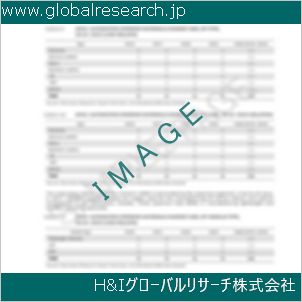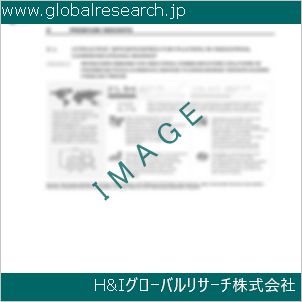Table of Contents
1 Industry Overview of Triallylamine
1.1 Definition and Specifications of Triallylamine
1.1.1 Definition of Triallylamine
1.1.2 Specifications of Triallylamine
1.2 Classification of Triallylamine
1.3 Applications of Triallylamine
1.3.1 Nuclear Application
1.3.2 Non-Nuclear Application
1.4 Industry Chain Structure of Triallylamine
1.5 Industry Overview and Major Regions Status of Triallylamine
1.5.1 Industry Overview of Triallylamine
1.5.2 Global Major Regions Status of Triallylamine
1.6 Industry Policy Analysis of Triallylamine
1.7 Industry News Analysis of Triallylamine
2 Manufacturing Cost Structure Analysis of Triallylamine
2.1 Raw Material Suppliers and Price Analysis of Triallylamine
2.2 Equipment Suppliers and Price Analysis of Triallylamine
2.3 Labor Cost Analysis of Triallylamine
2.4 Other Costs Analysis of Triallylamine
2.5 Manufacturing Cost Structure Analysis of Triallylamine
2.6 Manufacturing Process Analysis of Triallylamine
3 Technical Data and Manufacturing Plants Analysis of Triallylamine
3.1 Capacity and Commercial Production Date of Global Triallylamine Major Manufacturers in 2023
3.2 Manufacturing Plants Distribution of Global Triallylamine Major Manufacturers in 2023
3.3 R&D Status and Technology Source of Global Triallylamine Major Manufacturers in 2023
3.4 Raw Materials Sources Analysis of Global Triallylamine Major Manufacturers in 2023
4 Capacity, Production and Revenue Analysis of Triallylamine by Regions, Types and Manufacturers
4.1 Global Capacity, Production and Revenue of Triallylamine by Regions 2019-2024
4.2 Global and Major Regions Capacity, Production, Revenue and Growth Rate of Triallylamine 2019-2024
4.3 Global Capacity, Production and Revenue of Triallylamine by Types 2019-2024
4.4 Global Capacity, Production and Revenue of Triallylamine by Manufacturers 2019-2024
5 Price, Cost, Gross and Gross Margin Analysis of Triallylamine by Regions, Types and Manufacturers
5.1 Price, Cost, Gross and Gross Margin Analysis of Triallylamine by Regions 2019-2024
5.2 Price, Cost, Gross and Gross Margin Analysis of Triallylamine by Types 2019-2024
5.3 Price, Cost, Gross and Gross Margin Analysis of Triallylamine by Manufacturers 2019-2024
6 Consumption Volume, Consumption Value and Sale Price Analysis of Triallylamine by Regions, Types and Applications
6.1 Global Consumption Volume and Consumption Value of Triallylamine by Regions 2019-2024
6.2 Global and Major Regions Consumption Volume, Consumption Value and Growth Rate of Triallylamine 2019-2024
6.3 Global Consumption Volume and Consumption Value of Triallylamine by Types 2019-2024
6.4 Global Consumption Volume and Consumption Value of Triallylamine by Applications 2019-2024
6.5 Sale Price of Triallylamine by Regions 2019-2024
6.6 Sale Price of Triallylamine by Types 2019-2024
6.7 Sale Price of Triallylamine by Applications 2019-2024
6.8 Market Share Analysis of Triallylamine by Different Sale Price Levels
7 Supply, Import, Export and Consumption Analysis of Triallylamine
7.1 Supply, Consumption and Gap of Triallylamine 2019-2024
7.2 Global Capacity, Production, Price, Cost, Revenue, Supply, Import, Export and Consumption of Triallylamine 2019-2024
7.3 USA Capacity, Production, Price, Cost, Revenue, Supply, Import, Export and Consumption of Triallylamine 2019-2024
7.4 EU Capacity, Production, Price, Cost, Revenue, Supply, Import, Export and Consumption of Triallylamine 2019-2024
7.5 China Capacity, Production, Price, Cost, Revenue, Supply, Import, Export and Consumption of Triallylamine 2019-2024
7.6 Japan Capacity, Production, Price, Cost, Revenue, Supply, Import, Export and Consumption of Triallylamine 2019-2024
8 Major Manufacturers Analysis of Triallylamine
8.1 Manufacturer One
8.1.1 Company Profile
8.1.2 Product Picture and Specifications
8.1.2.1 Type I
8.1.2.2 Type II
8.1.2.3 Type III
8.1.3 Capacity, Production, Price, Cost, Gross and Revenue
8.1.4 Contact Information
8.2 Manufacturer Two
8.2.1 Company Profile
8.2.2 Product Picture and Specifications
8.2.2.1 Type I
8.2.2.2 Type II
8.2.2.3 Type III
8.2.3 Capacity, Production, Price, Cost, Gross and Revenue
8.2.4 Contact Information
8.3 Manufacturer Three
8.3.1 Company Profile
8.3.2 Product Picture and Specifications
8.3.2.1 Type I
8.3.2.2 Type II
8.3.2.3 Type III
8.3.3 Capacity, Production, Price, Cost, Gross and Revenue
8.3.4 Contact Information
8.4 Manufacturer Four
8.4.1 Company Profile
8.4.2 Product Picture and Specifications
8.4.2.1 Type I
8.4.2.2 Type II
8.4.2.3 Type III
8.4.3 Capacity, Production, Price, Cost, Gross and Revenue
8.4.4 Contact Information
8.5 Manufacturer Five
8.5.1 Company Profile
8.5.2 Product Picture and Specifications
8.5.2.1 Type I
8.5.2.2 Type II
8.5.2.3 Type III
8.5.3 Capacity, Production, Price, Cost, Gross and Revenue
8.5.4 Contact Information
…
9 Marketing Trader or Distributor Analysis of Triallylamine
9.1 Marketing Channels Status of Triallylamine
9.2 Traders or Distributors with Contact Information of Triallylamine by Regions
9.3 Ex-work Price, Channel Price and End Buyer Price Analysis of Triallylamine
9.4 Regional Import, Export and Trade Analysis of Triallylamine
10 Industry Chain Analysis of Triallylamine
10.1 Upstream Major Raw Materials Suppliers Analysis of Triallylamine
10.1.1 Major Raw Materials Suppliers with Contact Information Analysis of Triallylamine
10.1.2 Major Raw Materials Suppliers with Supply Volume Analysis of Triallylamine by Regions
10.2 Upstream Major Equipment Suppliers Analysis of Triallylamine
10.2.1 Major Equipment Suppliers with Contact Information Analysis of Triallylamine
10.2.2 Major Equipment Suppliers with Product Pictures Analysis of Triallylamine by Regions
10.3 Downstream Major Consumers Analysis of Triallylamine
10.3.1 Major Consumers with Contact Information Analysis of Triallylamine
10.3.2 Major Consumers with Consumption Volume Analysis of Triallylamine by Regions
10.4 Supply Chain Relationship Analysis of Triallylamine
11 Development Trend of Analysis of Triallylamine
11.1 Capacity, Production and Revenue Forecast of Triallylamine by Regions and Types
11.1.1 Global Capacity, Production and Revenue of Triallylamine by Regions 2024-2029
11.1.2 Global and Major Regions Capacity, Production, Revenue and Growth Rate of Triallylamine 2024-2029
11.1.3 Global Capacity, Production and Revenue of Triallylamine by Types 2024-2029
11.2 Consumption Volume and Consumption Value Forecast of Triallylamine by Regions, Types and Applications
11.2.1 Global Consumption Volume and Consumption Value of Triallylamine by Regions 2024-2029
11.2.2 Global and Major Regions Consumption Volume, Consumption Value and Growth Rate of Triallylamine 2024-2029
11.2.3 Global Consumption Volume and Consumption Value of Triallylamine by Types 2024-2029
11.2.4 Global Consumption Volume and Consumption Value of Triallylamine by Applications 2024-2029
11.3 Supply, Import, Export and Consumption Forecast of Triallylamine
11.3.1 Supply, Consumption and Gap of Triallylamine 2024-2029
11.3.2 Global Capacity, Production, Price, Cost, Revenue, Supply, Import, Export and Consumption of Triallylamine 2024-2029
11.3.3 USA Capacity, Production, Price, Cost, Revenue, Supply, Import, Export and Consumption of Triallylamine 2024-2029
11.3.4 EU Capacity, Production, Price, Cost, Revenue, Supply, Import, Export and Consumption of Triallylamine 2024-2029
11.3.5 China Capacity, Production, Price, Cost, Revenue, Supply, Import, Export and Consumption of Triallylamine 2024-2029
11.3.6 Japan Capacity, Production, Price, Cost, Revenue, Supply, Import, Export and Consumption of Triallylamine 2024-2029
12 New Project Investment Feasibility Analysis of Triallylamine
12.1 New Project SWOT Analysis of Triallylamine
12.2 New Project Investment Feasibility Analysis of Triallylamine
13 Conclusion of the Global Triallylamine (CAS 102-70-5) Industry 2024 Market Research Report
| ※参考情報 トリアリルアミン(Triallylamine)は、化学式 (C3H9N) を持つ有機化合物であり、CAS番号102-70-5で識別されています。この物質は、アミン類に分類される化合物であり、特徴的には三つのアリル基(C3H5)を持つため、トリアリルアミンという名称が付けられています。アミン類は一般的に、窒素原子に結合した有機基が一つ以上存在する化合物であり、トリアリルアミンはその中でも特異な構造を持っています。 トリアリルアミンの特徴の一つは、その不飽和性です。アリル基は二重結合を含むため、この化合物は化学反応において高い活性を示すことがあります。不飽和な構造は、多くの有機反応において重要な役割を果たします。また、トリアリルアミンの窒素原子は、他の化合物と容易に反応する性質を持っており、そのために多様な化学合成に利用されます。 トリアリルアミンにはさまざまな種類がありますが、一般的にはその合成方法や使用される条件によって異なる派生物が存在します。これには既存の構造に基づき、異なる置換基を持つアミンが含まれます。これらの派生物は特定の産業用途や研究において重要な役割を果たすことがあります。 トリアリルアミンの用途は多岐にわたります。主な用途の一つに、化学合成における中間体としての利用があります。これにより、さまざまな香料、染料、農薬の合成に貢献しています。また、トリアリルアミンは、界面活性剤や潤滑剤、さらには添加剤としても利用されており、工業界において重要な役割を果たしています。特に、医薬品や化粧品の分野では、安定性や生物分解性の点からも注目されることがあります。 トリアリルアミンは、商業的にも重要な化合物であり、様々な産業におけるニーズに対応した製品開発が進められています。例えば、電子材料の分野では、トリアリルアミンが半導体材料や光学材料の合成に利用されることがあります。これにより、次世代の電子デバイスや情報通信技術の進歩に貢献しています。また、高分子化合物やエポキシ樹脂の製造にも利用されることが多く、これらの材料は自動車産業や建設業にも広く使われています。 関連技術としては、トリアリルアミンを用いた反応のメカニズム、合成方法の開発、さらにはその応用分野の拡大についての研究が盛んに行われています。例えば、トリアリルアミンを触媒とした反応や、特定の条件下での選択的な反応に関する研究が進められています。これにより、より効率的かつ環境に優しい化学プロセスが模索されています。 また、環境への配慮から、トリアリルアミンの生分解性や毒性についての研究も進行中です。これにより、持続可能な化学プロセスの確立や、環境に優しい化合物の開発が期待されています。従来の合成方法からの革新が求められる中で、トリアリルアミンはその特性を活かし、環境負荷の少ない材料の一つとして注目されています。 最後に、トリアリルアミンは、その構造的特性、化学的反応性、幅広い用途により、さまざまな産業で重要な役割を果たしていることを強調したいと思います。今後もトリアリルアミンを含む化合物群の研究が進むことで、新たな応用が見いだされ、社会に貢献することが期待されています。即ち、化学の進展に寄与する重要な成分として、その知見を広げていくことが必要であると感じます。 |
❖ 免責事項 ❖
http://www.globalresearch.jp/disclaimer












